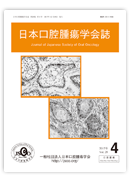Volume 29, Issue 4
Displaying 1-14 of 14 articles from this issue
- |<
- <
- 1
- >
- >|
The 35th Annual Meeting of Japanese Society of Oral Oncology
Symposium 2: The current therapeutic approach and future prospects in the elderly patients with oral cancer
-
2017 Volume 29 Issue 4 Pages 157
Published: December 15, 2017
Released on J-STAGE: December 22, 2017
Download PDF (597K) -
2017 Volume 29 Issue 4 Pages 158-164
Published: December 15, 2017
Released on J-STAGE: December 22, 2017
Download PDF (439K) -
2017 Volume 29 Issue 4 Pages 165-171
Published: December 15, 2017
Released on J-STAGE: December 22, 2017
Download PDF (1414K) -
2017 Volume 29 Issue 4 Pages 172-176
Published: December 15, 2017
Released on J-STAGE: December 22, 2017
Download PDF (498K) -
2017 Volume 29 Issue 4 Pages 177-181
Published: December 15, 2017
Released on J-STAGE: December 22, 2017
Download PDF (444K) -
2017 Volume 29 Issue 4 Pages 182-188
Published: December 15, 2017
Released on J-STAGE: December 22, 2017
Download PDF (819K) -
2017 Volume 29 Issue 4 Pages 189-195
Published: December 15, 2017
Released on J-STAGE: December 22, 2017
Download PDF (1298K)
Symposium 4: The indication of surgical treatment for oral cancer
-
2017 Volume 29 Issue 4 Pages 197
Published: December 15, 2017
Released on J-STAGE: December 22, 2017
Download PDF (538K) -
2017 Volume 29 Issue 4 Pages 198-205
Published: December 15, 2017
Released on J-STAGE: December 22, 2017
Download PDF (853K) -
2017 Volume 29 Issue 4 Pages 206-211
Published: December 15, 2017
Released on J-STAGE: December 22, 2017
Download PDF (407K) -
2017 Volume 29 Issue 4 Pages 212-217
Published: December 15, 2017
Released on J-STAGE: December 22, 2017
Download PDF (337K)
Case reports
-
2017 Volume 29 Issue 4 Pages 219-225
Published: December 15, 2017
Released on J-STAGE: December 22, 2017
Download PDF (827K) -
2017 Volume 29 Issue 4 Pages 227-232
Published: December 15, 2017
Released on J-STAGE: December 22, 2017
Download PDF (815K) -
2017 Volume 29 Issue 4 Pages 233-239
Published: December 15, 2017
Released on J-STAGE: December 22, 2017
Download PDF (1360K)
- |<
- <
- 1
- >
- >|
